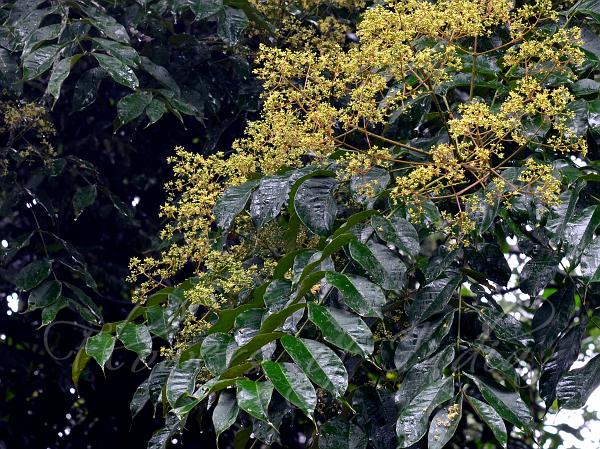|
| Indian Prickly Ash |
|

|

| File size | 1217200 |
| Original date | 7/24/16 12:04 PM |
| Resolution | 0 x 0 |
| Flash | Flash did not fire, auto |
| Focal length | 60.0mm |
| Exposure time | 1/60s |
| Aperture | 8.0 |
| Focus Distance | |
| Metering Mode | Multi-segment |
| Camera make | NIKON CORPORATION |
| Camera model | NIKON D5100 |
| Sensor type | OneChipColorArea |
|
|
|
|
Photo: |
Botanical name: Zanthoxylum rhetsa Family: Rutaceae (Lemon family)
Synonyms: Fagara rhetsa
Synonyms: Fagara rhetsa
Indian Prickly Ash is a deciduous tree about 12 m
tall. Trunk is armed with large corky conical prickles; bark brownish,
corky, yellow. Young branchlets are round, warty, hairless, with
conical prickles. Leaves are compound, imparipinnate, alternate,
spirally arranged, clustered at twig ends; axis channeled, hairless;
leaflet-stalk 0.3 cm long, channeled in cross section, hairless.
Leaflets are 15-23, opposite, 6.5-11 x 3.5-4.5 cm, oblong,
elliptic-oblong, tip falling off or tapering (tip up to 3 cm long),
base asymmetric, margin crenulate with glands at sinuses, leathery,
sparingly glandular punctuate; midrib channeled above; secondary nerves
6-12 pairs. Flowers are borne in panicles, at branch-ends or from
uppermost leaf axils. Flowers are polygamous, greenish yellow; male and
female flowers stalkless. Male flowers: sepals are 4, ovate-triangular,
fringed along margin, green; petals 4, free, elliptic-oblong, white or
creamy yellow, valvate; stamens 4, anthers oblong, yellow; disc
lobulate; pistillodes solitary. Female flowers: sepals & petals as in
male flowers; staminodes absent; disc pulvinate; ovary superior,
4-celled, ovules 2 in each cell; style eccentric; stigma flat.
Seed-pods are spherical, apiculate; seed 1, spherical, smooth,
bluish-black. Indian Prickly Ash is found in Indo-Malesia, in the
Western Ghats in India. Flowering: March-November.
Medicinal uses: The fruit and stem bark are
aromatic, stimulant, astringent, stomachic and digestive; prescribed in
urinary diseases, dyspepsia, diarrhoea and with honey in rheumatism.
Fruits are appetiser; useful in cholera, asthma, bronchitis, heart
troubles, piles and toothache; relieves hiccup. The carpels yield an
essential oil, which is given in cholera. The seed oil is antiseptic
and disinfectant; applied on inflammatory dermatosis. The seed oil is
used in dry eczema and dandruff of children in Bangladesh. The root
barks have cholinergic, hypoglycaemic and spasmolytic activity.
The fruit and stem bark are
aromatic, stimulant, astringent, stomachic and digestive; prescribed in
urinary diseases, dyspepsia, diarrhoea and with honey in rheumatism.
Fruits are appetiser; useful in cholera, asthma, bronchitis, heart
troubles, piles and toothache; relieves hiccup. The carpels yield an
essential oil, which is given in cholera. The seed oil is antiseptic
and disinfectant; applied on inflammatory dermatosis. The seed oil is
used in dry eczema and dandruff of children in Bangladesh. The root
barks have cholinergic, hypoglycaemic and spasmolytic activity.
Medicinal uses:
 The fruit and stem bark are
aromatic, stimulant, astringent, stomachic and digestive; prescribed in
urinary diseases, dyspepsia, diarrhoea and with honey in rheumatism.
Fruits are appetiser; useful in cholera, asthma, bronchitis, heart
troubles, piles and toothache; relieves hiccup. The carpels yield an
essential oil, which is given in cholera. The seed oil is antiseptic
and disinfectant; applied on inflammatory dermatosis. The seed oil is
used in dry eczema and dandruff of children in Bangladesh. The root
barks have cholinergic, hypoglycaemic and spasmolytic activity.
The fruit and stem bark are
aromatic, stimulant, astringent, stomachic and digestive; prescribed in
urinary diseases, dyspepsia, diarrhoea and with honey in rheumatism.
Fruits are appetiser; useful in cholera, asthma, bronchitis, heart
troubles, piles and toothache; relieves hiccup. The carpels yield an
essential oil, which is given in cholera. The seed oil is antiseptic
and disinfectant; applied on inflammatory dermatosis. The seed oil is
used in dry eczema and dandruff of children in Bangladesh. The root
barks have cholinergic, hypoglycaemic and spasmolytic activity. | Identification credit: Savinaya Malve, Anurag Sharma | Photographed at Sagara, Karnataka. |
• Is this flower misidentified? If yes,